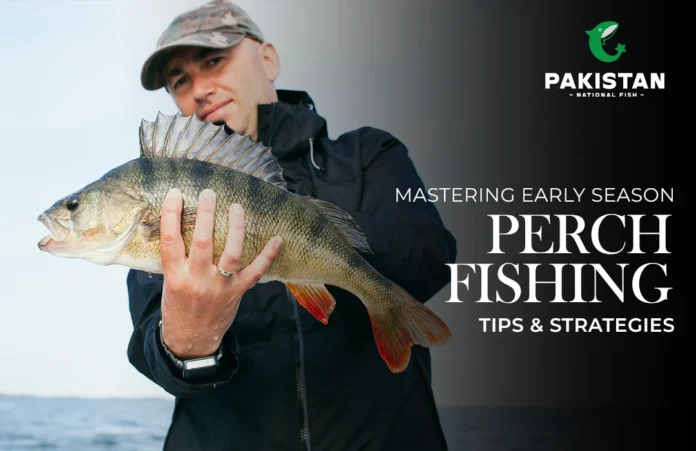Knowing Perch: Diet, Size, And Lifespan
Your method selection requires understanding fundamental knowledge about the fish species you pursue.
What’s the Average Lifespan of Perches?
The lifespan of perch reaches 10-12 years but most perches survive only about 7 years between birth and death. Perch depend on high-quality habitats and sufficient food to develop properly and survive throughout their life.
How Big Do Perch Get?
The dimensions of perch fish types depend on their specific species and geographical location. In optimal conditions, yellow perch grows up to 15 inches long and typically ranges from 6 to 12 inches in normal circumstances. A trophy perch may reach heavier than 2 pounds.
What Do Perch Eat?
Most perch base their food consumption on fish smaller than themselves, insects, crustaceans, and various types of larvae. The fishing season in early spring results in perch seafood targeting minnows and worms since these prey items offer significant protein content hence live fishing bait proves highly effective.
Best Time To Catch Perch
Perch fishing in early spring achieves its best outcomes during the morning and evening periods because these are their most active moments under low light conditions. Perch gather at shallows to consume their food during this period but this behavior makes them accessible for anglers to detect.
Seasonal Feeding Patterns:
- The fishing period reaches its peak when perch are actively feeding for the best catch fish rates during spring.
- The season of summer drives perch into deeper waters because of the rising summer heat.
- The perch become more active in their feeding behavior just before winter arrives.
- The natural biological processes during winter cause metabolism rates to slow down but ice fishing techniques become the most successful approach.
Best Way to Fish for Perch
The successful catch of yellow perch requires proper technique selection. Several successful strategies exist for perch fishing as listed below.
- Live Bait Fishing
Minnows together with worms and leeches serve as the most successful live baits to catch fish. The fish will respond better to your bait when it moves slightly since such motion attracts perch.
- Jigging
Using either small jigs with soft plastic baits or live bait results in a highly effective fishing experience. Perch respond to bait movements at the bottom level because jigging imitates the natural swimming of prey.
- Float Fishing
A slip bobber rig with a small hook and live bait provides excellent results by floating your bait to the right depth where perch often dwells.
- Bottom Fishing
You should let your weighted rig descend to the bottom floor when attempting perch catches in areas where they cluster at depth.
- Trolling
The method of slowing trolling with small crankbaits or spinners helps fishermen find bigger perch schools in extensive waters.
Perch Fishing Gear & Setup
Key equipment plays an essential role in your success rate while perch fishing.
Best Line for Ultralight Fishing
Perch fishermen benefit most from using Ultralight tackle because it enables better sensitivity to their bite. When fishing ultralight a 4-6 lb test monofilament or fluorocarbon line stands out as the best selection because it combines strength attributes with precise castability.
Rods & Reels
Light or ultralight spinning rods between 5-7 feet long should be combined with a matching small spinning reel. The setup gives anglers both strong control as well as heightened sensitivity needed to detect bites.
Lures & Baits
- Small Jigs (1/32 – 1/16 oz)
- Soft Plastic Grubs & Twisters
- Live Baits (Minnows, Nightcrawlers, Leeches)
- Small Crankbaits & Spinners
- Inline Spinners & Spoons
Identifying Perch's Ideal Locations
When targeting perch during early-season fishers need to determine their search locations.
Shallows water: Thorough anglers search for shallows that contain underwater vegetation and sandy or muddy sea floors.
Drop-offs and structure: The location of underwater structures and dropped materials as well as rocks and submerged functions as primary gathering spots for perch.
Near inlets and outlets: Marine resources flowing from inlet or outlet points create unique attractions for baitfish which brings perch to this area.
Weedy area: Weeds create hiding places which enable perch to catch their prey by ambush.
Bridges and piers: Perch find bridges and piers attractive because shade areas combined with baitfish aggregation make these platforms their preferred fishing zone.
Perch Survey: Tracking Populations
Keeping track of perch populations across a certain region becomes possible with the implementation of a perch survey method. Wildlife agencies perform these surveys as a method to follow perch population health patterns and changes in size. Fishermen contribute to perch research by documenting their fishing catches while recording their fish sizes together with their exact spot locations and water conditions.
The process of performing your own perch survey involves these steps:
- Note the fish size along with the weight for every caught specimen.
- The surveyor must record both location characteristics and collect data about water depth and structure and water temperature measurements.
- Document the effectiveness of different bait choices in terms of catching feeding perch.
- Analyze the catch trends by month to establish seasonal patterns.
Ice Fishing for Perch
During winter patients in cooler regions can succeed at perch fishing through ice fishing activities. Here are some useful tips:
- The best perch bait during winter is to employ small tungsten jigs, which should be combined with wax worms or maggots.
- You need to drill numerous holes while shifting your position to discover schools actively feeding.
- Perch prefer dwelling at locations where they can find cover under underwater features and near areas where other perch have amassed.
- Use a flasher device together with a fish finder to locate perch through ice depths.
Final Tips for Success
- Use smaller hooks together with light tackle since perch have tiny mouths.
- Switch to different fishing methods since current techniques have not been effective.
- The fish behave in a demanding manner which requires extended periods of waiting. Adjust your presentation methods whenever you get light nibbles from your fishing target.
- One perch catch indicates numerous perch remain nearby since they keep school formation patterns.
- The activity of perch becomes more active under overcast conditions which adds to the benefits of light wind patterns.
- Adding crushed minnows and worms to the water through chumming will increase your chances of attracting perch to the area.
- Pakistani cuisine contains versatile Mrigal fish that people cook through multiple preparation methods.
- Fried Mrigal Fish represents a popular food option after being seasoned with various spices followed by deep-frying.
- Mrigal Fish Curry features a combination of tomatoes onions and usual Pakistani spices during cooking.
- The grilled preparation of Mrigal Fish provides both health benefits and brings out its organic taste.
- Steamed Mrigal Fish represents a nutritious fish dish that includes rice and vegetables on the plate.


